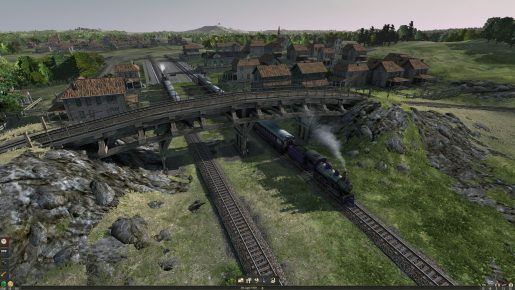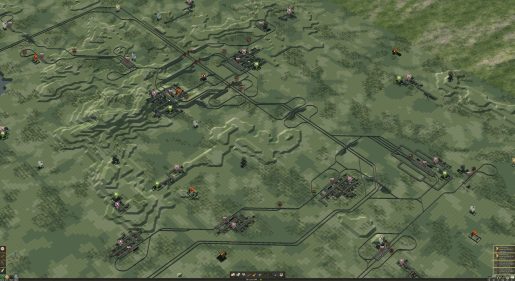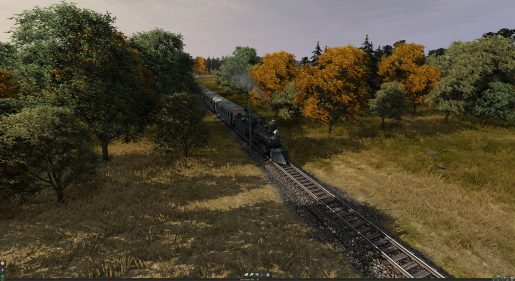The curiously titled Mashinky describes itself as a transport strategy game about trains, made by solo developer Jan Zelený. Mashinky was recently released on Steam Early Access, offering the core gameplay with the promise of additional content and features to come. The easiest comparison to another game is Transport Tycoon (a free open source version of which is available as OpenTTD), but Mashinky sets itself apart from its peers with an interesting resource system inspired by board games.
In similar titles all of your transport lines would be focused on making money, perhaps by exploiting several tiers of an industrial chain but always the final value of a line would be measured in the single resource, money. In Mashinky only passenger and mail deliveries provide you with a money resource, which is still important, but other industries will provide you with tokens of different resources like wood, coal or steel. Many of the later upgrades and trains have a cost in these other resources, forcing the player to diversify and set up trains to cover all the various industries as well as passengers, particularly if you want to use some of the more advanced trains which have ongoing coal costs.
Requiring all of the industries to be covered prompts the player to think about production chains rather than just the relatively simple matter of hauling passengers around. Critically this means there is no one industry which is the most efficient way to make money; they all make different kinds of money so you need them all. The one downside to this is that you have no choice about it, you absolutely need all of the industries so can’t choose to focus on one thing which might be how some want to play, but this I think is a small price to pay for a significantly more interesting resource system.
To build any of these supply chains or transport lines you are going to need to be placing rails down, and this is where Mashinky really stands out. In the screenshots you will see both a realistic view with gently sloping terrain and pretty forests covering the landscape, and a polygonal simplified view reminiscent of the isometric graphics of transport tycoon. This latter view is the build mode which is accessed by pressing space, instantly switching between these views. The construction is tile-based which makes it simple to place track exactly as you want and helping the board game feeling, as well as making terraforming tools precise and intuitive. Navigating the terrain between stations with your rails is a generally painless experience, while throwing up interesting decisions about how best to efficiently route your line to avoid excessive inclines and corners.
One of the most important aspects of setting up your rail network is the signalling, without which you won’t be able to safely run more than a single train on any line. As it stands the only signals available in Mashinky are block signals, which divide the line up into blocks which allow only one train into them at any given time. This allows fairly complex rail networks but does result in fairly complex junction designs being needed to remove the possibility of deadlocks while retaining efficiency. Fortunately path signals (chain signals to Factorio players) are one of the many planned additions for the early access process, which will allow for more compact efficient junctions, giving many more options for players.
In the game at the moment are only the first two eras: the early steam age and the steam age. In the first of these the only industries are passenger transport and tool-shops which take wood planks and coal, with mail and steel industries appearing as the age transitions. A total of seven ages are planned, taking the number of industries up to 21 from the current 7, and 28 railway engines from the current 8. More production chains and options will really help Mashinky have some longevity, as will the also planned inclusion of Steam Workshop support so that modders can also add even more industries and vehicles.
The realistic graphics mode looks good and provides an enjoyable way to view the rail network you’re building, particularly if you use the view mode to ride on your trains, though the train textures can look a bit muddy when viewed that close up. The build mode isn’t quite so pretty but is very clear, which is exactly what you want in this kind of game. The scaling of the buildings to the landscape really evokes a sense of this being a model railway, which is both endearing and nostalgic. The sounds in the game are also good with trains making satisfying chugging sounds and blowing whistles as they enter tunnels, and with a pleasant if soundtrack if you choose to listen to it.
Mashinky features a charming seasonal system as the years pass, as the above screenshot shows with the beginnings of the transition to autumn. This doesn’t seem to have any effect on gameplay but does really add to the presentation. As it currently stands Mashinky has a fixed user interface scale, which appears very small on a 4k display as it is in the screenshots; this is less of a problem than in some games in large part due to how thorough the hotkeys are. On the steam discussion forums though the developer has indicated that a UI scaling option is something which will be looked at in the future.
If you’re interested in the genre then Mashinky is certainly worth taking a look at, and even if you’ve never played anything similar this might well be for you if you’ve ever wanted to play with a train set. It’s unclear exactly how long some of the planned features, which include eight-player multiplayer, will take to be added, but the game has already seen a significant patch with improved train pathing and some interface improvements since the release last week. Overall the developer has stated that the game is expected to be in early access for 1-2 years, and I for one will be keeping close track (bad pun intended) of the game as it develops. Mashinky is available now on Steam or the humble store for £18.99/$24.99 or your regional equivalent.
[Editor’s Note: Mashinky was provided to us by the developer for the preview.]




